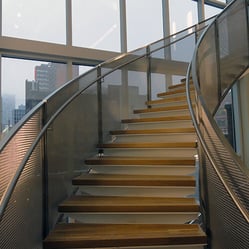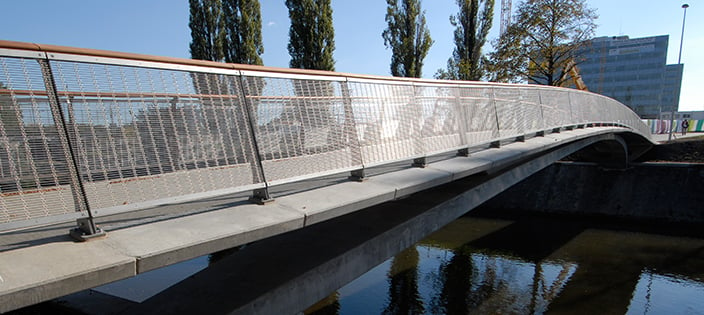How Architectural Wire Mesh Is Used For Balustrade Railing
There are many elements to a structure that architects must apply decorative design materials to create a memorable visitor experience. Whether on the interior or exterior of the structure, one element that often goes overlooked is the balustrades system.
This is because architects are more concerned with adhering to the safety regulations that dictate the installation of balustrade railing than their overall aesthetic. That said, there are many design materials, such as architectural wire mesh, that provide architects with a means of complying with these balustrade safety regulations while also delivering an awe-inspiring design.
This probably leaves you curious as to how architectural mesh is applied to balustrade railing systems.
W.S. Tyler has over 20 years of experience helping customers implement architectural mesh and is here to help you take your architectural design process to new heights.
To ensure you have a complete understanding of architectural wire mesh balustrades railing systems, this article will cover:
- What architectural mesh is
- How architectural mesh is applied to balustrade railing systems
- The benefits architectural mesh provides to balustrade systems
- How much architectural mesh costs
What Is a Architectural Wire Mesh Panel?
Architectural wire mesh is best defined as a series of metallic wires that run vertically and horizontally after undergoing a centuries-old weaving process that allows it to be used for decorative applications. As it is must stand the test of time, architectural mesh is primarily constructed from 300 series stainless steel to ensure maximum durability is delivered.
Now, one of the most significant reasons wire mesh panels are becoming more widely used is the fact that all specifications, including mesh pattern, percentage of open area, panel size, and wire diameter, are all customizable and calculated before being woven.
How Is Architectural Wire Mesh Applied to Balustrade Railing Systems?

Typically, when designing balustrade railing, architectural mesh is supplied to a railing manufacturer in cut-to-size infill panels. These manufacturers are behind the fabrication of the railing system itself, with architectural mesh being added as a decorative element during the fabrication process.
That said, framing systems that house the architectural wire mesh panels can be used when designing and installing a balustrade system.
This can be done using a square tube frame, bending the wire mesh panel at a 90-degree angle on all sides and spot welding it to the frame. The framed wire mesh panel is then bolted to the railing system.
You can also use two pieces of flat bar to sandwich the wire mesh panel and use the flat bar to bolt the panel to the railing system.
Why Use Architectural Wire Mesh for Balustrade Railing Systems?
As architectural wire mesh is one of the most unique design materials on the market, balustrade infill panels deliver several benefits to the world of architectural design. These benefits include weight, visitor safety, and pliability.
Weight
Glass panels are a popular solution when designing balustrade systems, as they provide a sense of transparency. That said, these panels tend to fall on the heavier side of the spectrum.
By using architectural wire mesh, you still maintain this sense of transparency while significantly reducing the amount of weight the system must hold.
Visitor Safety
One of the most significant aspects of designing a balustrade system is complying with the safety regulations intended to keep pedestrians safe. As all parameters of wire mesh panels are fully customizable, each panel can be modified to accommodate these regulations with ease.
Pliability
One of the best qualities associated with architectural wire mesh is that, because it's a woven wire product, there is a lot of movement/play allotted when fitting the mesh into a frame or balustrade system directly. This is particularly beneficial when the balustrade railing runs along a stairwell.
To accommodate the slope of the stairs, the balustrade system must run at an angle. This means when material, such as perforated plate, is used, the material must be cut at an angle, resulting in substantial waste material.
With architectural mesh, the mesh panel simply needs to be skewed to run in the same direction as the stairs, leaving you with far less waste material. This ultimately saves you money in the long run.
How Much Does Architectural Wire Mesh Cost?
As far as supply the cut-to-size mesh panels alone, the overall price of architectural mesh is approximately $20 to $25 per square foot. This, of course, is dependent on what the construction of your mesh looks like, including the mesh type, level of fabrication needed, panel quantity, aperture size, and weight.
Once you begin adding additional material and hardware, such as framing systems, you can expect this price range to increase.
Better Understand If Architectural Wire Mesh Is Right for You With Mesh Samples
Architectural wire mesh is a series of horizontal and vertical metallic wires woven together to form wire mesh panels. As the characteristics of architectural mesh allow it to be cut and manipulated with ease, architects often implement it when designing balustrade railing systems.
Having said that, the best way to determine if architectural mesh is suitable for you is to request samples of the mesh profiles you feel could turn your vision into a reality. Doing so allows you to experience the physical qualities of the mesh first-hand.
As W.S. Tyler has helped customers integrate architectural wire mesh for over 20 years, we strive to learn your process to help you leverage the qualities of architectural mesh and turn your vision into a reality.
To learn more about architectural mesh samples, review our article: What Is an Architectural Mesh Sample? (Definition, Limitations, & Cost).
About Ronnie Brown
Ronnie is the Content Writer for W.S. Tyler and has four years of experience as a professional writer. He strives to expand his knowledge on all things particle analysis and woven wire mesh to leverage his exceptional writing and graphic design skills, creating a one-of-a-kind experience for customers.




